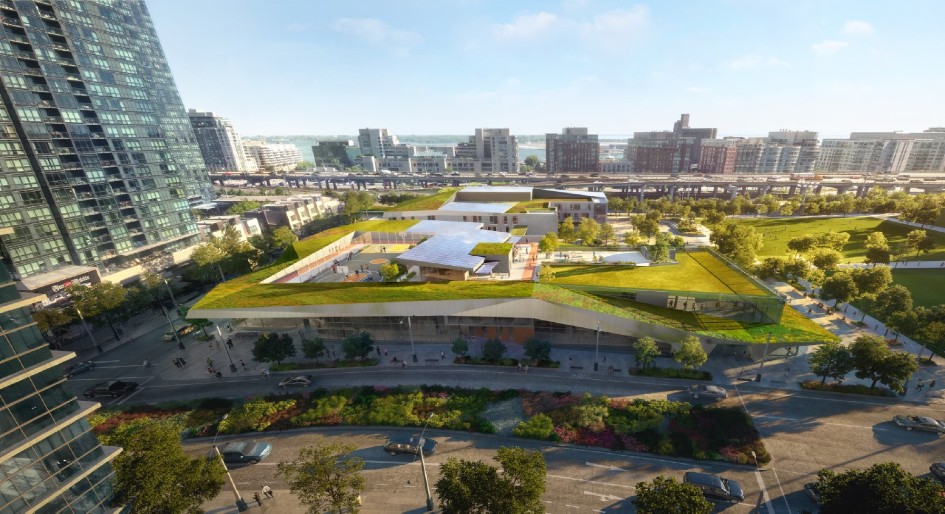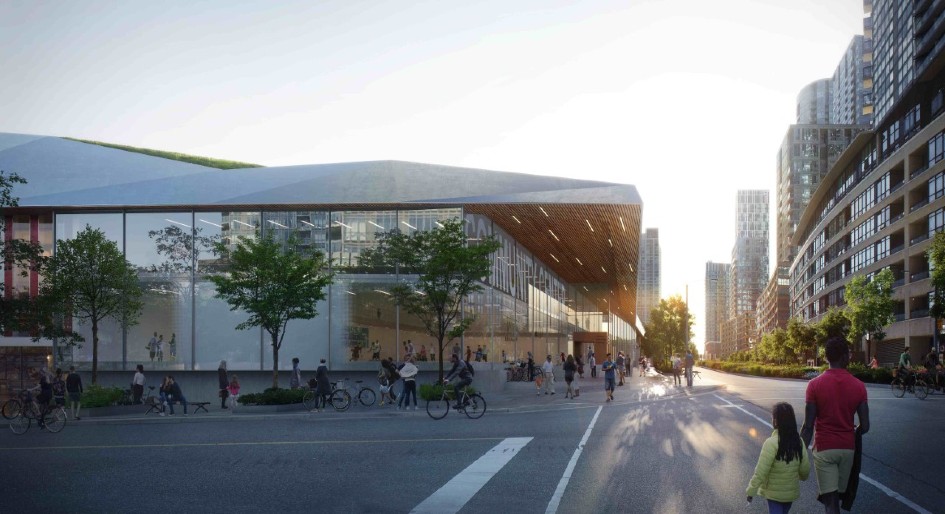How to socially distance in spaces charged for social interactions? This is just one challenge facing community centres as they prepare for reopening—bit by bit—across Ontario.
Municipal social hubs—from recreation centres to libraries—have switched to live-streaming during the pandemic and community members are growing accustomed to the flexible approach. Such is the impetus for a new perspective on design that includes a hybrid of physical and virtual programming. How the pandemic might shape the future of these facilities is front and centre in the minds of designers like ZAS Architects’ Principal Peter Duckworth-Pilkington. Here, he talks about the changing role of community centres like Canoe Landing Campus—the firm’s new downtown Toronto community centre/multi-school complex serving CityPlace.

Canoe Landing Campus
How is Canoe Landing Campus fostering a social experience during COVID-19?
As the community centre and schools are still closed by provincial order, Canoe Landing Campus’ social programming has focused on the exterior elements, such as the community open plaza, that allow for physically-distanced small gatherings. The site’s naturalized landscape elements and public art afford a relief from the typical urban environment. In addition, critical services such as children’s day camps, run by City of Toronto Parks Forestry and Recreation, along with the childcare centre are open and fulfilling their critical social role. In preparation for a green light by public health officials to reopen, Canoe Landing Campus’ other community facilities such as the gyms, indoor playground, community kitchen, fitness studios, rooftop park, and program rooms are all being planned to allow for save use.
How might a hybrid model of physical and virtual programming inform the future design of community centres?
Even before the lock down, there was more demand for remote and asynchronous access to programming. For example, it is difficult for most of us to commit to, say, a cooking class at the community centre every Wednesday night for 10 weeks due to work, family and other obligations. Yet studies have shown, and many of us have felt during this period of isolation, the value of physically getting together with others in a shared activity. Providing a hybrid model of physical and virtual programming, where a participant can have a high-quality experience either in the physical space or remotely, is an important offering to address this dichotomy. As we adjust to this ‘new normal,’ being able to extend the physical architectural space to the web will be critical to allow a diverse range of users to fully participate in community events, regardless of their individual obligations or location.
How can these social hubs encourage safe collaboration among varying groups—from a more senior population to young children who are unable to social distance properly?
Most community centre programming is scheduled and requires registration, whereby they can limit the numbers of participants and schedule the movement of people through a space. In fact, ‘drop-in’ programming may be limited or eliminated as a key method to reduce possible risk of contact and spread.
Programming for more vulnerable groups can be timed to avoid programming for those, like young children, who may have more trouble with physical distance. Beyond the programming methods, design interventions can also be integrated to limit the spread of the virus, including one-way circulation paths, distancing cues and signage, and no-touch light switches and door openers. We should also make better use of outdoor spaces, which have lower risk of transmission, including sports courts, rooftops and outdoor gathering and learning spaces. Toronto’s extreme climate has tended to compel activities indoors for much of the year but as designers and architects, we have an opportunity to embrace our four-season city and outdoor living through clever design interventions. This could mean placement of shelter elements to block winter winds and shade the summer sun or localised mist cooling or winter heating to mitigate extreme temperatures. It is important to remember that COVID-19 is a new disease and science’s understanding of its transmission is still evolving so it is critical that design responses remain agile and ready to adapt as new public health advice is disseminated.
For older facilities, what are some creative solutions for retrofitting spaces to make them COVID-safe?
The scheduling discussed above is an important measure that can be reasonably implemented in existing facilities. Design interventions are more challenging, however, signage and distance cues such as floor markings can be implemented. Installing automatic controls especially for lighting and plumbing fixtures are more expensive, but will often provide energy and water use savings that will offset costs, provide long-term environmental benefits and generate employment in this uncertain economy.
Do you think these physical spaces will matter even more post-pandemic?
During this period of collective isolation, the necessity of community spaces has never felt more urgent. Even as the world has embraced remote ways of “gathering,” we have also realized their limitations. While virtual classes and meetings are convenient, and necessary in lockdown, the data shows that physically meeting in one place is still extremely valued by people from all demographics.
Yet, many people simply do not have the access to virtual programming, meaning a key function of community centre programming—providing equal access for all—is not being achieved through online offerings. Now, more than ever, civic facilities like Canoe Landing Campus are learning the benefits of physical, online, and hybrid programming options and understanding what type of programming is best suited to which modality. Going forward, I am hopeful that this newfound appreciation of public space will lead to further investment, a broadening of the kinds of programming being offered in community centres, and more flexibility to choose how we access this programming—be it in-person or from our computer at home.




